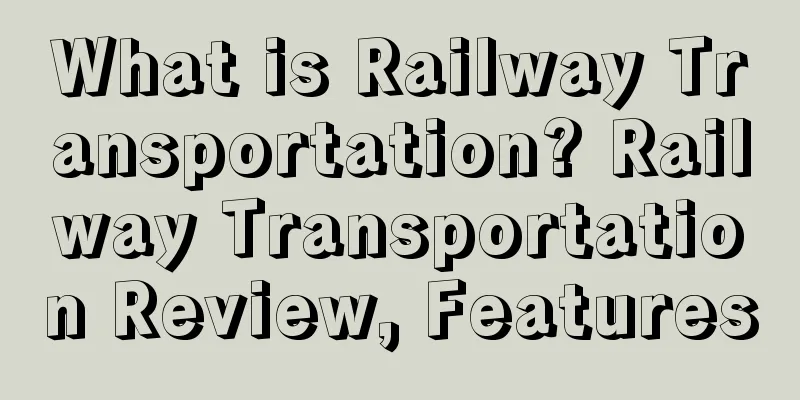What is Railway Transportation? Railway Transportation Review, Features

|
Railway transportation is a mode of transportation that uses railway trains to transport goods. Railway freight transportation is one of the main modes of modern transportation and one of the two basic modes of transportation that constitute land transportation.
Development History Greece was the first country to have rail transport. Horse-drawn carts had been running along tracks for at least 2,000 years. In 1804, Richard Trevithick invented the first steam locomotive that could travel on rails in Wales, England, but he did not make much money. The first successful steam locomotive was the "Rocket" built by George Stephenson in 1829. In the 1820s, the Stoughton and Darlington Railway in England became the first successful steam locomotive railway. The subsequent Liverpool and Manchester Railway further demonstrated the huge development potential of railways. Railways soon became common in Britain and around the world, and they became the world leader in transportation for nearly a century until the invention of airplanes and automobiles reduced their importance. The first railway in China, the Wusong Railway, was built in Shanghai by the British, but was later bought back and demolished by local officials of the Qing Dynasty. The first railway and steam locomotive officially used were built by the Kailuan Coal Mine founded by Li Hongzhang.
type Railway freight transport types refer to the railway freight transport modes. According to China's railway technical conditions, the current railway freight transport types are divided into three types: full truckload freight transport, less-than-load freight transport, and container freight transport. Full truckload is suitable for transporting bulk goods; less-than-load is suitable for transporting small quantities of sporadic goods; and containers are suitable for transporting delicate, valuable, and fragile goods.
advantage 1. From the perspective of technical performance, the advantages of railway transportation are: (1) Fast running speed, generally between 80 and 120 kilometers per hour. (2) Large transport capacity. Generally, each passenger train can carry about 1,800 passengers, a freight train can carry 2,000 to 3,500 tons of cargo, and a heavy-load train can carry more than 20,000 tons of cargo. The maximum annual cargo transport capacity of a single-line in one direction is 18 million tons, and that of a double-line in one direction is 55 million tons. In countries with better operating organization, the maximum annual cargo transport capacity of a single-line in one direction is 40 million tons, and that of a double-line in one direction is more than 100 million tons. (3) The railway transportation process is less restricted by natural conditions and has strong continuity, which can ensure year-round operation. (4) It has good general performance and can transport both passengers and various types of goods. (5) The arrival and departure times of passenger and freight transport by train are highly accurate. (6) The train runs relatively smoothly, safely and reliably. (7) The average transport distance is 25 times that of road transport and 1.15 times that of pipeline transport, but less than half of that of water transport and less than 1/3 of that of civil aviation transport. 2. From the perspective of economic indicators, the advantages of railway transportation are: (1) Railway transportation costs are relatively low. In 1981, my country’s railway transportation costs were 1/11-1/17 of automobile transportation costs and 1/97-1/267 of civil aviation transportation costs. (2) Energy consumption is relatively low. The standard fuel consumption per thousand ton-kilometer is 1/11-1/15 of that of automobile transportation and 1/174 of that of civil aviation transportation. However, both indicators are higher than those of coastal and inland river transportation.
shortcoming 1. The investment is too high. The cost of a single-track railway is between 1 million and 3 million yuan per kilometer, and the cost of a double-track railway is between 4 million and 5 million yuan. 2. The construction period is long. It takes 5-10 years to build a trunk line. Moreover, it occupies too much land. As the population grows, it will add more burden to society. 3. Affected by factors such as transportation time, vehicle allocation, train formation, and mid-distance marshaling, it cannot meet the urgent needs of customers, and the cost of short-distance transportation is high. In logistics, railway transportation is often used to complete medium- and long-distance, large-volume cargo transportation tasks.
Contract of carriage When a consignor transports goods by rail, he or she shall sign a cargo transportation contract with the carrier. A truckload bulk material transportation contract signed on a quarterly, semi-annual, annual or longer basis shall be accompanied by a monthly vehicle request schedule. For other truckload goods, a monthly vehicle request schedule may be used as a transportation contract. A cargo waybill shall also be submitted to the carrier when the goods are delivered. A cargo waybill shall be used as a transportation contract for LTL goods and goods transported in containers. The preparation of the monthly freight transport plan shall be carried out in accordance with the provisions of the "Regulations on the Preparation of Railway Monthly Freight Transport Plans".
The Development of Air Transport and Its Impact on Railway Transport With the development of economy and the improvement of people's living standards, the proportion of air transport for long-distance passenger transport and high-end commodity freight will continue to grow, which will inevitably have a certain impact on long-distance railway transport. In other words, the scale of a country's air transport development is closely related to its economic development level, which in turn affects the scale of railway transport during this period. The development of air transport, on the one hand, has pushed the railway to continuously increase the speed of trains, enabling the rapid development of high-speed railways worldwide; on the other hand, aviation's service concepts, service standards, service methods and innovative reform methods have played a positive role in promoting the railway to improve service quality. |
<<: What is Prime Samples? Prime Samples Review, Features
>>: What is Business Report? Business Report Review, Features
Recommend
What is ZoodMall? ZoodMall Review, Features
ZoodMall is a mobile shopping app from Switzerland...
What is BitBrowser? BitBrowser Review, Features
BitBrowser is a browser developed by Beijing BitIn...
A large number of sellers rushed to SHEIN, and the hot-selling categories were revealed!
From the initial women's clothing track to th...
Online market share soars, with 35.2% of Western European consumers buying groceries online
In 2021, the global grocery market grew by 2.1% ,...
What is Orange sellers? Orange sellers Review, Features
Orange sellers is an Amazon accelerator. About Or...
What is Skunow? Skunow Review, Features
Skunow will take your business to a competitive le...
AliExpress Double 11 sales are booming, merchants say: orders can't stop
“ The stock was sold out in one hour ?” At 5pm on...
6 products are hot-selling on Amazon, and Shenzhen's best seller has received tens of millions in financing!
Recently, smart hardware company Jihai Technology...
eBay will prioritize CPC ads on search pages
Consumers often use the search function to select...
A large number of operators are considering switching platforms
Job hunting season is also a season of confusion!...
What is Jiezhou Technology? Jiezhou Technology Review, Features
Jiezhou Technology (Shenzhen Jiezhou Technology Co...
What is Raccoon Logistics Overseas Warehouse? Raccoon Logistics Overseas Warehouse Review, Features
As an Amazon SPN service provider, Raccoon Logist...
One piece sold in 5 seconds! Amazon's popular categories face both danger and opportunity
The industry is in decline and the market is nega...
What is Anchorage Digital? Anchorage Digital Review, Features
Anchorage Digital is a digital asset bank. About ...
What is Jiacheng International Logistics? Jiacheng International Logistics Review, Features
Hangzhou Jiacheng International Logistics Co., Lt...









